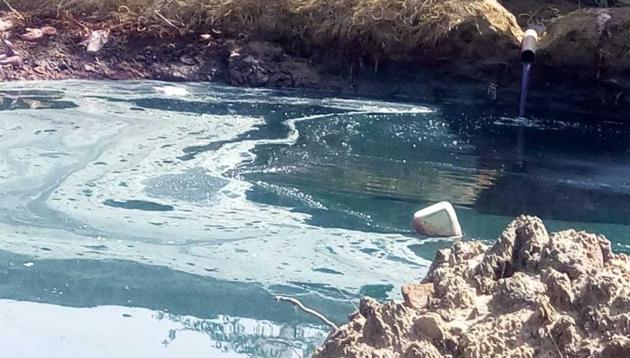Once a lifeline for Marwar, Luni river now fighting pollution
Discharge of untreated effluents by textile industries into Luni has turned river water unfit for agriculture and contamination of groundwater poses dangers to health.
The Luni river was once considered a lifeline for Rajasthan’s Marwar region as it provided drinking water to inhabitants of the area and sustained production of wheat, gram, bajra and other seasonal crops on the basin. However, in the past few decades, the river water has been unfit for crops and posing dangers to health because of discharge of hazardous pollutants by textile industries.

The pollutants have not only contaminated the river water and groundwater in surrounding areas but also raised concern about the Luni’s existence.
Om Soni, secretary of ‘Pradushan Niwaran and Paryavarn Sanrakshan Samiti’, a voluntary organisation fighting against river pollution, said despite court orders textile industries are not obeying green norms and discharging hazardous pollutants into the Luni.
“Without collusion of pollution control board authorities, it is not possible for industries to violate green norms on such a large scale,” Soni alleged.
“Once Luni river was a boon for farmers as it provided water for agriculture. But due to pollutants, now the river water is not useful for crops. Chemical water is damaging crops,” Soni said.
“Apart from stopping discharge of pollutants into the river, we are also fighting for compensation to farmers whose crops got damaged due to chemical water.”
The Luni originates from Nag Pahar near the Pushkar valley of Ajmer and flows southwest through Nagaur, Jodhpur, Barmer and Jalore over a distance of about 500 km, covering a catchment area of 37,363 km. The river is also known as the ‘Maruganga’ of the Marwar region of the western Rajasthan. A main river on the west of the Aravali range, the Luni meets the Arabian sea in the Rann of Kutch.
Natural flow lost
About 800 textile and dyeing industries are running on the Luni banks at Balotra, Bithuja, Jasol, and Pali. Employment avenues spurred urbanisation in the region. Balotra industrial town is famous for handblock printing and textile industries. A leading textile centre for the last 60 years, Balotra is also known for colouring and printing of yarn and polyester fabrics.
The Luni has freshwater during its flow for first 100 kilometres. As it reaches Balotra town in Barmer, 110 km southwest of Jodhpur city, the water starts turning saline. The river loses its natural flow and carries industrial waste and domestic sewage. The water becomes unfit for use.
Untreated or partially treated effluents discharged by industries make way into the Luni at Balotra and other surface water bodies of the area.
Acidic effluents from industries have reached much below the surface and contaminated wells and aquifers at villages, such as Asada, Asotra, Tapra, Padru, Dakha, and Khed. The pollution of land, water and air has affected people.
Textile units violating green norms
In May 2018, while hearing a public interest litigation, the National Green Tribunal (NGT) declared the Luni water unfit for irrigation on the basis of an inspection report submitted by the tribunal’s monitoring committee.
The report said the level of total dissolved solids (TDS) in the groundwater in the area was 9,000 mg/l, and 400-1,600 mg/l in surrounding areas. The report blamed the textile dyeing units for polluting groundwater and the river.
The Rajasthan high court’s order banning discharge of untreated water into the Luni was ignored by the industries. Considering the violation of green norms, the court had ordered shutdown of 800 textile units.
After the units assured the court to obey green norms, the court allowed their functioning.
In January this year, NGT had ordered an inspection report about the condition of Luni river by examining the functioning of ETPS (effluent treatment plants), CETPS (common effluent treatment plants), HRTS (high rate transpiration system) and other facilities at Bithuja, Balotra and Jasol.
The committee -- comprising Dr Ajay A Deshpande, former expert member, NGT, New Delhi and Dr Ajit Pratap Singh, professor and dean, BITS, Pilani -- has recently submitted the report to the green tribunal.
Committee members found that Luni is polluted due to discharge of industrial effluents and sewage disposal. Polluted water discharged into Luni and flowing into surrounding areas is a constant threat to the riverine system, health of villagers and agriculture.
Installed CETPS are not achieving zero liquid discharge (ZLD) and effluents are being discharged into Luni directly or indirectly, the report said.
According to the report, industries with individual effluent treatement plants and solar evaporation do not comply fully with environmental quality standards. Industries discharging effluents to CETPS do not comply with norms as they do not have primary effluent treatment plants (PETPS).
Soni said the court had many times ordered the local authorities to monitor the situation and take action against violators but they did not take it seriously, which resulted in textile industries violating green norms and discharging pollutants into Luni.
Soni said the the National Green Tribuanl had considered their plea and imposed penalties on textile industries for violating environmental norms.
The court had directed the local administration to prepare an assessment report for the crop loss in the area so that compensation would be disbursed among farmers, he said.
Himanshu Gupta, Barmer district collector, said following the court’s direction, the agriculture department is preparing a crop assessment report, which would be submitted to the court soon.
Encroachments in catchment area
Apart from discharge of dangerous pollutants into the river, encroachment in the catchment area is a big problem. Kumparam Majiwala, former village sarpanch of Majiwala and social activist, said as Luni is a seasonal river, land mafia had encroached upon the catchment area.
“Local authorities announced many times to remove encroachments but due to political pressure no serious effort was made,” Majiwala alleged.
“Apart from stopping discharge of dangerous pollutants into the river, government should take serious note of the encroachments in the catchment area,” he said.



